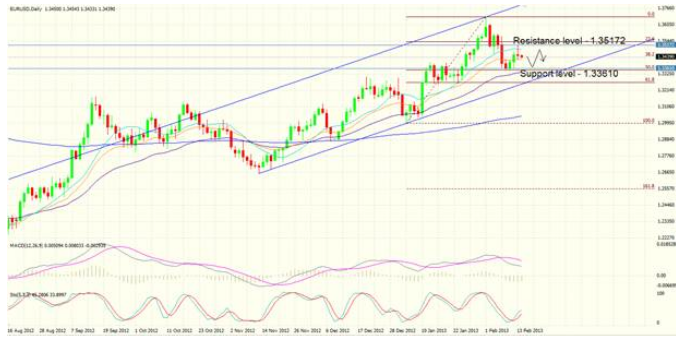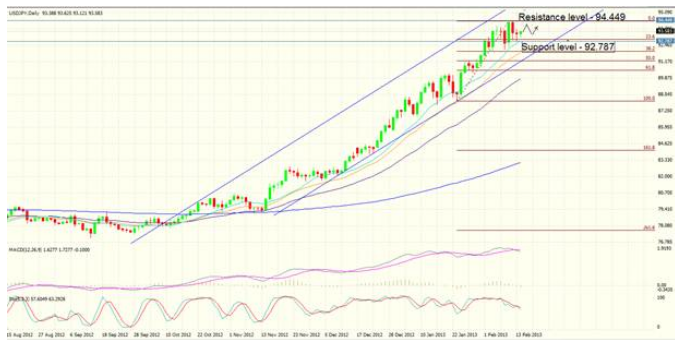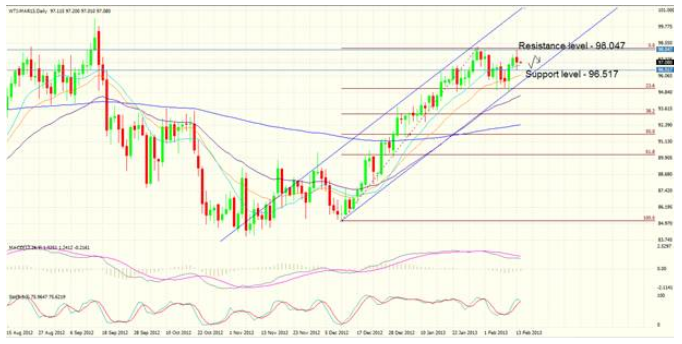- German GDP (QoQ) (GER, 07:00 GMT)
- French Non-Farm Payrolls (QoQ) (FRA, 07:45 GMT)
- ECB Monthly Report (EU, 09:00 GMT)
- GDP (QoQ) (EU, 10:00 GMT)
- Initial Jobless Claims (U.S, 13:30 GMT)
Democrats and Republicans in the U.S. Congress are nowhere near a plan to avert $1.2 trillion in spending cuts about two weeks before they are set to begin. It’s the latest in a series of fiscal deadlines created by Congress that in the past two years took the U.S. to the brink of a debt default, a government shutdown and middle-class tax increases that neither party wanted. Unless lawmakers act, the across-the-board spending reductions will begin March 1.
Japan’s economy unexpectedly shrank last quarter as falling exports and a business investment slump outweighed improved consumption, bolstering Prime Minister Shinzo Abe’s case for further monetary stimulus to end deflation. Gross domestic product contracted an annualized 0.4 percent, following a revised 3.8 percent fall in the previous quarter, the Cabinet Office said in Tokyo today.
As the world’s advanced economies grow at half the speed of the pre-crisis years amid persistently high unemployment, governments are turning to a new set of monetary-policy makers who in word - and hopefully, deed - are more aggressive than their predecessors. A revolution that began with the arrival of Mario Draghi in November 2011 at the European Central Bank, is now gathering speed as Canada’s Mark Carney joins the Bank of England and the Bank of Japan awaits a new governor. The changing of the guard reflects both a need for central banks to offset fiscal paralysis, and a bet that monetary policy remains a potent force. At the same time, investors are increasingly weighing the costs and benefits of quantitative easing, while suggesting too much is expected of central banks, according to an article published by Bloomberg News.
EUR/USD: The EUR/USD was trading lower at 1.34390 at the time of writing after Portugal’s jobless rate rose to the highest. Market sentiments remain weak on the Euro as the median forecast in a Bloomberg News Survey showed, the euro-area economy will shrink at a faster pace last quarter. Economists predict the 17-nation economy will contract by 0.4 percent, after reversing 0.1 percent last quarter. In addition, investors are searching for safety in the liquid greenback ahead of a Group of 20 summit due to open in Moscow on Friday. The Group of Seven industrialized nations said in a recent statement that weakening currencies, the yen most notably, must not escalate into active devaluations, and subsequent talk that G20 leaders at a Moscow meeting will address exchange rates and monetary policy later this weekend. Other events likely to bring volatility on the market are the German GDP (QoQ) (Forecast: -0.5% - Previous: 0.2%), the French Non-Farm Payrolls (QoQ) (Forecast: -0.2% - Previous: -0.3%), the Spanish industrial New Orders (YoY) (Forecast: -1.0% - Previous: -1.5%), the ECB Monthly Report and the Italian GDP (QoQ) (Forecast: -0.6% - Previous: -0.2%). Later in the day, the U.S will release its key risk event, the Initial Jobless Claims, which is forecast to come at 360K compared to 366K registered last week. The resistance level is at 1.35172 and the support level is at 1.33610. EUR/USD" title="EUR/USD" width="684" height="344">
EUR/USD" title="EUR/USD" width="684" height="344">
USD/JPY: The USD/JPY was trading higher at 93.583 at the time of writing after the Bank of Japan’s decision to keep its asset purchases unchanged and on speculation the central bank will add stimulus next month as the nation’s economy slows. The yen fell after former BOJ Deputy Governor Kazumasa Iwata, a potential candidate to become the next central bank head, signaled the currency has scope to depreciate further. Moreover, data showed today that Japan’s gross domestic product unexpectedly shrank in the fourth quarter. According to an article published by Bloomberg news, Japan’s currency has entered a range of between 88 to 98 per dollar, according to Sakakibara, known as “Mr. Yen” for his efforts to influence exchange rates in the late 1990s. An official from a G7 nation said Japan will be in the spotlight at the G20 gathering this weekend amid concern the yen’s slide has been excessive. “Guiding the yen lower is a policy that punishes neighboring nations,” Sakakibara, 71, said in an interview in Tokyo yesterday. Impressions overseas that Japan is trying to orchestrate further declines in the yen mean that “it will be criticized by the G-7, as well as the G-20,” he said. Investors should focus on the Group of 20 summit due to open in Moscow on Friday to get visibility. Event likely to affect the market today is the Initial Jobless Claims in the U.S, which is forecast to come at 360K compared to 366K registered last week. Data in the Euro area will also affect market sentiments. Tomorrow, Japan will release its Industrial Production (MoM) (Forecast: unchanged at 2.5%). The resistance level is at 94.449 and the support level is at 92.787. USD/JPY" title="USD/JPY" width="682" height="346">
USD/JPY" title="USD/JPY" width="682" height="346">
WTI (Oil): Oil was trading was trading lower at 97.080 at the time of writing after U.S. crude output climbed to a 20-year high, and Iran said it made progress in talks with United Nations nuclear inspectors. According to the Energy Information Administration, U.S. crude production rose to its highest since December 1992 and stockpiles increased. On the other hand, Iran, which is under Western embargo on its oil exports, said it bridged some differences with the International Atomic Energy Agency in talks in Tehran on its nuclear program. In Addition, the economy in Japan, the world’s third-biggest oil user, unexpectedly shrank last quarter. Gross domestic product contracted an annualized 0.4 percent in the three months through December, following a revised 3.8 percent contraction in the previous quarter, the Cabinet Office said in Tokyo today. Market sentiments remain weak on the commodity. Events likely to bring some fluctuations on the commodity are the German GDP (QoQ) (Forecast: -0.5% - Previous: 0.2%), the French Non-Farm Payrolls (QoQ) (Forecast: -0.2% - Previous: -0.3%), the Spanish industrial New Orders (YoY) (Forecast: -1.0% - Previous: -1.5%), the ECB Monthly Report, the GDP (QoQ) in the Eurozone (Forecast:-0.4% - Previous: -0.1%) and the Italian GDP (QoQ) (Forecast: -0.6% - Previous: -0.2%). Later in the day, the U.S will release its key risk event, the Initial Jobless Claims, which is forecast to come at 360K compared to 366K registered last week. The resistance level is at 96.047 and support level is at 96.517.
